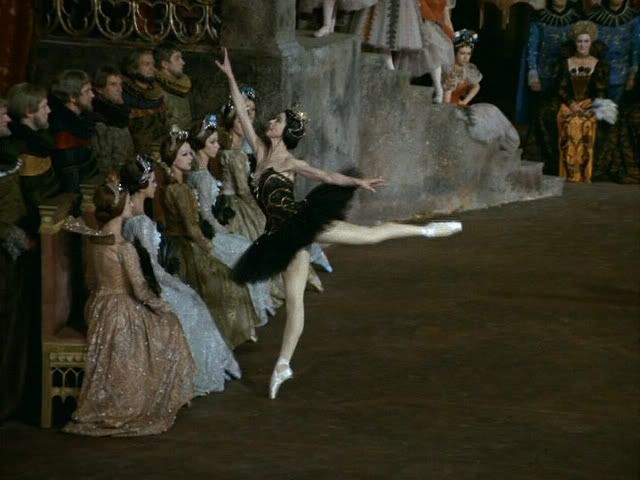A ballerina standing en pointe is debatably one of the most beautiful sights in the world. In my mind, it doesn’t matter whether you have a high, medium, or low arch. This is really kind of a silly question, like asking “what’s better, flexibility or strength?” There isn’t an answer.
Many dancers or teachers though prefer dancers with a higher arch. Their feet naturally look amazing and their lines look more graceful than those with a lower or flat foot. However as both a dancer and a teacher, I believe that neither is better or worse. They both have their advantages and disadvantages.

Dancers with a naturally high and flexible foot tend to get all the way up—or too far over—their shoes. Many will stand up on the whole platform of the pointe on their first try. They have an easier time finding their balance and don’t have a problem getting up on pointe. They do, however, tend to have more trouble controlling the process of going down. I see a lot of new pointe students with high arches go up no problem, but then clop down on their heels, or shake when they’re up there.
>>>>>You might like: Everything you need to know about Pointe.
Dancers with a lower arch, however, have the opposite problem. Many of us (yes, I’m one of them!) have to work very hard to get all the way up on our shoes, and we tend to dance behind pointe, on the ridge of the shoe rather than the platform. It requires a lot of strength to get all the way up (and sometimes some shoe alterations. More on that later). However, because the dancer has had to gain the strength to get up, they don’t have as much trouble rolling down with control as a high-footed dancer.


Another interesting thing is an action called “breaking at the ankle.” This is where you go up onto pointe and bend your knees, but instead of pushing over on the box, you hold your ankle where it is. Dancers with flatter feet have no problem with this movement, and toe hops and promenades and most partnering come very naturally to them. However, dancers with a higher arch find breaking at the ankle nearly impossible because their feet are already curved so far over.
>>>>>You might like: Pointe Readiness
Both high and low arches look beautiful in pointe shoes. Neither is better than the other. However, know that dancers with high arches can learn to do difficult things like toe hops, and dancers with lower arches can improve their arch.
DON’T:
Good luck, happy dancing, and don't use a foot stretcher!
Thanks for visiting! Just so you know, my blog contains affiliate links, which generate commission for me off your purchase. Learn more about that here.. All reviews are 100% my own opinion. Any item featured may have been received free in exchange for promotion or review, but does not in any way affect my review. See the rest of my privacy policy, review policy, and disclaimer here. Thank you for supporting Beyond the Barre!
(Margot Fonteyn: look at her feet! She had a low arch! There’s nothing wrong with that!)
Many dancers or teachers though prefer dancers with a higher arch. Their feet naturally look amazing and their lines look more graceful than those with a lower or flat foot. However as both a dancer and a teacher, I believe that neither is better or worse. They both have their advantages and disadvantages.

Dancers with a naturally high and flexible foot tend to get all the way up—or too far over—their shoes. Many will stand up on the whole platform of the pointe on their first try. They have an easier time finding their balance and don’t have a problem getting up on pointe. They do, however, tend to have more trouble controlling the process of going down. I see a lot of new pointe students with high arches go up no problem, but then clop down on their heels, or shake when they’re up there.
>>>>>You might like: Everything you need to know about Pointe.
Dancers with a lower arch, however, have the opposite problem. Many of us (yes, I’m one of them!) have to work very hard to get all the way up on our shoes, and we tend to dance behind pointe, on the ridge of the shoe rather than the platform. It requires a lot of strength to get all the way up (and sometimes some shoe alterations. More on that later). However, because the dancer has had to gain the strength to get up, they don’t have as much trouble rolling down with control as a high-footed dancer.


>>>>>You might like: Pointe Readiness
Both high and low arches look beautiful in pointe shoes. Neither is better than the other. However, know that dancers with high arches can learn to do difficult things like toe hops, and dancers with lower arches can improve their arch.
There are a few really awesome ways to improve your arch:
- Do some snakes in demi-pointe, pushing your feet over on demi-relevé instead of a full relevé. (see video)
- Releves in coups de pied, getting high up on your foot and lowering the heel slowly
- tendu to the side, roll the toes down onto the ground but keep the ankle pointed, press the arch and bend the working leg, straighten again, and close your tendu articulating through your feet
- Roll your foot on a tennis ball or golf ball (gently massaging the tendons) to slowly loosen the muscles.
- Watch this video
- And this one.
- Use a foot stretcher
- Ask someone to sit on your feet
- Force your arch against a wall or a stair
- Any other myriad of dangerous stretches.
Good luck, happy dancing, and don't use a foot stretcher!










